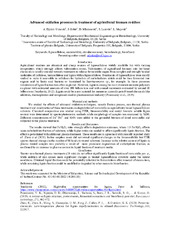Приказ основних података о документу
Advanced oxidation processes in treatment of agricultural biomass residues
| dc.creator | Đukić-Vuković, Aleksandra | |
| dc.creator | Grbić, Jovana | |
| dc.creator | Mladenović, Dragana | |
| dc.creator | Lazović, Saša | |
| dc.creator | Mojović, Ljiljana | |
| dc.date.accessioned | 2023-03-20T13:56:41Z | |
| dc.date.available | 2023-03-20T13:56:41Z | |
| dc.date.issued | 2022 | |
| dc.identifier.uri | http://TechnoRep.tmf.bg.ac.rs/handle/123456789/6219 | |
| dc.description.abstract | Introduction Agricultural residues are abundant and cheap sources of lignocellulose widely available but with varying composition which strongly affects valorization routes. Valorization of agricultural biomass into bio-based chemicals is usually oriented towards treatments to release fermentable sugars from complex and strongly bonded molecules of cellulose, hemicellulose and lignin within lignocellulose. Treatments of lignocellulose were mostly studied to make it accessible to cellulases for hydrolisis of carbohydrates which could be then fermented into organic acid by lactic acid bacteria or bioetahnol by Saccharomyces sp., for example. In these processes valorization of lignin fraction was often neglected. However, lignin is among the most abundant aromatic polymers on planet with estimated amounts of over 300 billion tons and with annual increments estimated by around 20 billion tons (Smolarski, 2012). Lignin could be a raw material for numerous currently petrol-based chemicals like additives, thermoplastics and compounds used in pharmaceutical industry (Ponnusamy et al., 2019). Material and methods We studied the effects of advanced oxidation techniques, namely Fenton process, non-thermal plasma treatment and combination of these treatments on degradation of corn stalks as agroindustry based lignocellulosic substrate. Chemical composition was studied using FTIR, bioaccessibility and acetyl bromide soluble lignin content were determined by spectrophotometric methods while morphology of samples was examined by SEM. Different concentrations of Fe2+/Fe3+ and H2O2 were added to the grounded biomass of dried corn stalks and subjected to the plasma treatment. Results and Discussion The results showed that Fe/H2O2 ratio strongly affects degradation outcomes, where 1:5 Fe/H2O2 affects more carbohydrate fraction of substrate, while higher ratios are needed to affect significantly lignin fraction. The effect is potentiated with additional plasma treatment. These results are in agreement with recently reported study of Zhou et al (2020). Iodine sorption assey did not reveal significant changes in the bioaccesibility but FTIR spectra showed changes in the number of H-bonds in treated substrate. Increase in the relative content of lignin in plasma treated samples was probably a result of more prominent degradation of carbohydrate fraction, as confirmed by an increase in glucose content in liquid fraction of treatment media. Conclusion Shorter non-thermal plasma treatments (10 min) do not affect significantly lignin fraction of corn stalks per se, while addition of iron causes more significant changes in treated lignocellulose substrate under the milder conditions. Obtained liquid fraction could be potentially valorized in fermentations after removal of excess iron, while remaining lignin fraction could be modified or degraded by other means in biorefineries. | sr |
| dc.language.iso | en | sr |
| dc.relation | info:eu-repo/grantAgreement/MESTD/inst-2020/200135/RS// | sr |
| dc.rights | openAccess | sr |
| dc.rights.uri | https://creativecommons.org/licenses/by/4.0/ | |
| dc.source | 9th International Conference on Sustainable Solid Waste Management | sr |
| dc.subject | lignocellulose | sr |
| dc.subject | sustainability | sr |
| dc.subject | circular economy | sr |
| dc.subject | biotechnology | sr |
| dc.subject | biorefinery | sr |
| dc.title | Advanced oxidation processes in treatment of agricultural biomass residues | sr |
| dc.type | conferenceObject | sr |
| dc.rights.license | BY | sr |
| dc.identifier.fulltext | http://TechnoRep.tmf.bg.ac.rs/bitstream/id/16424/bitstream_16424.pdf | |
| dc.identifier.rcub | https://hdl.handle.net/21.15107/rcub_technorep_6219 | |
| dc.type.version | publishedVersion | sr |

